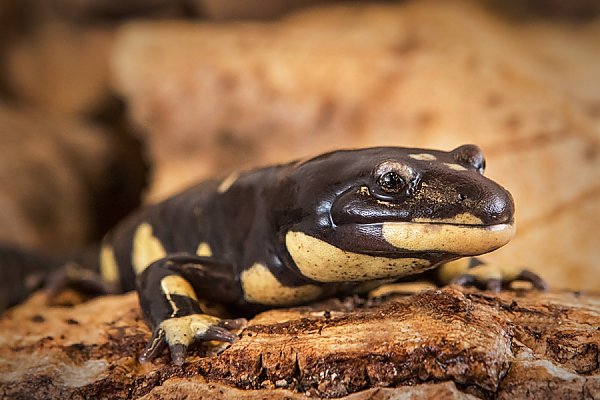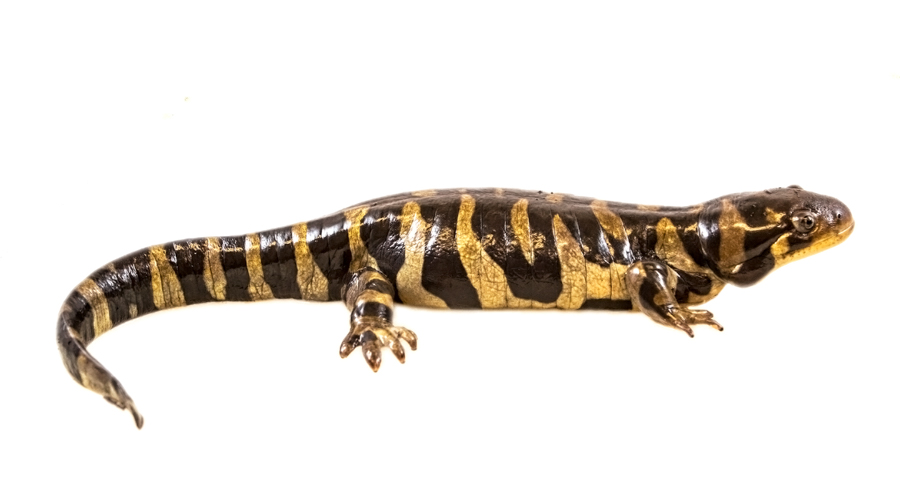Tiger Salamander
Ambystoma tigrinum
The largest terrestrial North American salamander, the tiger salamander is a member of the mole salamander family. They begin their life in water, later metamorphosing into air-breathing adults. They have a robust black, dark gray or brown-colored body with yellow or white stripes, splotches or spots and short, stubby legs. Tiger salamanders are endemic to various habitats throughout North America. The International Union for Conservation of Nature (IUCN) lists them as a species of Least Concern.


SPECIES IN DETAIL
Tiger Salamander
Ambystoma tigrinum
CONSERVATION STATUS: Least concern
CLIMATE CHANGE:
At the Aquarium
Tiger salamanders are on exhibit in the Frogs: Dazzling and Disappearing exhibit area in the Tropical Pacific Gallery.
Geographic Distribution
Tiger salamanders are found from the Mexican Plateau’s southern edge, north throughout the United States, to eastern Alaska, and east to southern Labrador.
Habitat
This species lives in marshy areas, grasslands, or forests depending on the area of the country. They need soil in which to burrow, spending most of their time in burrows up to 2 feet (0.61 meters) deep, and access to a permanent body of water for breeding purposes.
Physical Characteristics
The tiger salamander is a large terrestrial salamander with a black, dark gray, or brown-colored dorsal side covered with yellow or white stripes, splotches, or spots. These markings are unique to each animal. They have a yellow or olive ventral side with some dark color mixing in. They have a robust body with short stubby legs, large head, and broad, rounded snout, and round eyes. Males tend to have a more compressed tail, longer hind legs, and a longer body. Males have a swollen vent area during breeding season. This salamander produces a toxic secretion used for self-defense from a poisonous tail gland. They pump air in and out of their lungs by gular pumping (raising and lowering the floor of their mouth).
Size
These salamanders grow up to 7 to 13 inches (17 to 33 centimeters) long. Their average length is 6 to 8 inches (15 to 20 centimeters).
Diet
Tiger salamanders are voracious nocturnal feeders, emerging from their burrows at night to feed on insects, worms, snails, frogs, other salamanders, and slugs.
Reproduction
Sexually mature at five to six years, salamanders migrate in late winter or early spring to ponds to breed. Courtship beings at night. The male/female pair will circle and bump each other on the bottom of the pond. The female will follow the male, nudging his vent area and stimulating him to deposit his spermatophore. The female moves so that the spermatophore touches her vent, allowing her to take the sperm into her cloaca, fertilizing her eggs. Eggs are laid at night (from March to June in northern higher elevations and July to August in the southwestern United States) approximately two to three days after courtship. Each egg mass may contain as many as a hundred eggs. Females may produce from one hundred to one thousand eggs per season. The eggs will adhere to underwater debris and hatch after three to five weeks. They metamorphose into adults two to five months after hatching, losing their gills and gaining lungs.
Behavior
Adults are typically terrestrial animals entering the water only to breed.
When threatened, they will display their poisonous tail gland by curling up their head and tail.
Adaptation
Tiger salamanders have specialized foot pads used for burrowing.
Longevity
This species may live up to twenty-five years under human care.
Conservation
While this species is listed as Least Concern by IUCN, they are affected by wetland and forest habitat loss and pollution.
SPECIES IN DETAIL | Print full entry
Tiger Salamander
Ambystoma tigrinum
CONSERVATION STATUS: Least concern
CLIMATE CHANGE:
Tiger salamanders are on exhibit in the Frogs: Dazzling and Disappearing exhibit area in the Tropical Pacific Gallery.
Tiger salamanders are found from the Mexican Plateau’s southern edge, north throughout the United States, to eastern Alaska, and east to southern Labrador.
This species lives in marshy areas, grasslands, or forests depending on the area of the country. They need soil in which to burrow, spending most of their time in burrows up to 2 feet (0.61 meters) deep, and access to a permanent body of water for breeding purposes.
The tiger salamander is a large terrestrial salamander with a black, dark gray, or brown-colored dorsal side covered with yellow or white stripes, splotches, or spots. These markings are unique to each animal. They have a yellow or olive ventral side with some dark color mixing in. They have a robust body with short stubby legs, large head, and broad, rounded snout, and round eyes. Males tend to have a more compressed tail, longer hind legs, and a longer body. Males have a swollen vent area during breeding season. This salamander produces a toxic secretion used for self-defense from a poisonous tail gland. They pump air in and out of their lungs by gular pumping (raising and lowering the floor of their mouth).
These salamanders grow up to 7 to 13 inches (17 to 33 centimeters) long. Their average length is 6 to 8 inches (15 to 20 centimeters).
Tiger salamanders are voracious nocturnal feeders, emerging from their burrows at night to feed on insects, worms, snails, frogs, other salamanders, and slugs.
Sexually mature at five to six years, salamanders migrate in late winter or early spring to ponds to breed. Courtship beings at night. The male/female pair will circle and bump each other on the bottom of the pond. The female will follow the male, nudging his vent area and stimulating him to deposit his spermatophore. The female moves so that the spermatophore touches her vent, allowing her to take the sperm into her cloaca, fertilizing her eggs. Eggs are laid at night (from March to June in northern higher elevations and July to August in the southwestern United States) approximately two to three days after courtship. Each egg mass may contain as many as a hundred eggs. Females may produce from one hundred to one thousand eggs per season. The eggs will adhere to underwater debris and hatch after three to five weeks. They metamorphose into adults two to five months after hatching, losing their gills and gaining lungs.
Adults are typically terrestrial animals entering the water only to breed.
When threatened, they will display their poisonous tail gland by curling up their head and tail.
Tiger salamanders have specialized foot pads used for burrowing.
This species may live up to twenty-five years under human care.
While this species is listed as Least Concern by IUCN, they are affected by wetland and forest habitat loss and pollution.

